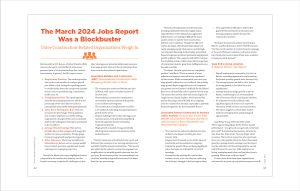The March 2024 Jobs Report Was a Blockbuster
Three Construction-Related Organizations Weigh In
Each month the U.S. Bureau of Labor Statistics (BLS) issues a jobs report, and the March 2024 report garnered quite a bit of attention from the construction industry. In general, the BLS report covers:
- Employment Numbers: This section provides data on the total number of nonfarm payroll jobs added or lost during the reporting period. It usually breaks down the numbers by industry sectors such as manufacturing, construction, health care, etc.
- Unemployment Rate: The report typically includes the unemployment rate, which is the percentage of the total labor force that is unemployed and actively seeking employment.
- Labor Force Participation Rate: This rate measures the percentage of the population that is either employed or actively seeking employment. Changes in this rate can indicate shifts in the willingness of people to participate in the workforce.
- Average Hourly Earnings: This section provides data on the average hourly wages for workers in various industries. It helps gauge trends in wage growth and purchasing power.
- Other Indicators: There may be additional information on factors such as average weekly hours worked, part-time employment trends, and long-term unemployment rates.
Overall, the March jobs report highlighted robust job growth in the construction industry and the broader economy, coupled with challenges such as labor shortages and potential inflationary pressures from wage growth. Here are the top takeaways from three construction-related organizations.
Associated Builders and Contractors (ABC): Nonresidential Construction Adds Whopping 24,600 Jobs in March
- The construction industry added 39,000 jobs in March, with a year-over-year increase of 270,000 jobs.
- Nonresidential construction employment increased by 24,600 positions, with growth across all three subcategories.
- The construction unemployment rate fell to 5.4% in March, indicating strong employment growth in the sector.
- Despite challenges like worker shortages and materials prices, both privately and publicly financed segments showed substantial employment growth.
- Wage growth remained strong, potentially affecting future interest rate decisions by the Federal Reserve.
“Today’s release was a blockbuster jobs report and indicates that recession is not arriving anytime soon,” said ABC Chief Economist Anirban Basu. “The 39,000 jobs added by the nation’s construction segment was roughly twice the monthly growth observed over the past year. If one focuses purely on nonresidential construction, monthly job growth was nearly 80% faster than the one-year average.
“Structural transformations in the economy, including replenished domestic supply chains, expanded data center demand and augmented infrastructure, are making it difficult for many project owners to wait for lower construction delivery costs,” said Basu. “Despite the effects of worker shortages, still-elevated materials prices, newly emerging supply chain issues, and the high cost of project financing, both privately and publicly financed segments produced substantial employment growth in March. This comports with ABC’s Construction Confidence Index, which shows that a large share of contractors intend to grow their staffing levels over the next 6 months.
“As always, the jobs report was not completely positive,” said Basu. “Those in search of lower inflation and interest rates will not be comforted by this release. While economywide year-over-year wage growth softened to 4.1% in March, the monthly wage growth figure suggested a pace of compensation growth that will render it difficult for the Federal Reserve to substantially reduce interest rates in 2024. The notion that interest rates will remain higher for longer remains firmly in place, which means that project financing costs will likely be an ongoing issue for construction demand, especially in privately financed segments, for the foreseeable future.”
Associated General Contractors of America (AGC) Analysis: Construction Sector Adds 39,000 Jobs between February and March with Increases in Every Residential and Nonresidential Category
- The construction industry added 39,000 jobs in March, the largest monthly gain since January 2023.
- Employment increased across all five types of residential and nonresidential categories.
- Despite the growth, firms are facing significant labor shortages, as indicated by record job openings.
- Average hourly earnings for construction workers rose by 4.9% over the year, reflecting the industry’s struggle to find enough workers.
- AGC urged federal officials to address the gap between investment in education and training programs and the demand for construction workers.
“All types of construction firms were hiring in March,” said Ken Simonson, AGC’s Chief Economist. “But the record number of construction job openings at the end of February indicates contractors would have hired even more workers if they were available to keep pace with demand.”
Sage Policy Group Analysis: A (Nearly) Perfect Jobs Report
- Payroll employment increased by 303,000 in March, exceeding expectations and matching the fastest monthly growth since January 2023.
- The unemployment rate fell to 3.8%, driven by strong growth in the labor force and
employment. - Average hourly earnings grew by 0.35% in March, contributing to a 4.2% annualized rate of increase, which could impact inflation.
- No industries lost jobs in March, with significant gains in sectors such as private education, health services, and construction.
- The report suggests a robust labor market with low unemployment and growing job opportunities.
Sage Policy Group COO Zack Fritz noted, “We’re approaching Oprah levels of labor market
performance—you get a job, you get a job, everybody gets a job!” In answering the question, what do we take from this, Fritz wrote, “You can forget about recession. This is about as good as jobs reports get. Sure, you could quibble about the faster-than-ideal growth in average hourly earnings, and this report ups the odds that we’ll be waiting until the second half of the year for rate cuts. Still, employers are hiring, unemployment is low, and the labor force is growing. What more could you want?”
To learn more from these three organizations, visit www.abc.org, www.agc.org, and www.sageecon.com.

